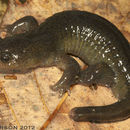Description
provided by AmphibiaWeb articles
The tail is shorter than snout-vent length. The coloration is blackish-brown above, dispersed with a greyish-brown pattern. Vomerine teeth in V-shape. Gular fold present. 11-13 costal grooves.
Zhao, E. (1998). China Red Data Book of Endangered Animals: Amphibia and Reptilia. Science Press: Endangered Species Scientific Commission, P.R.C., Beijing.
Distribution and Habitat
provided by AmphibiaWeb articles
These salamanders are found in northeast China in the following areas: Liaoning (Xiongyue), Jilin, and Heilongjiang.
Life History, Abundance, Activity, and Special Behaviors
provided by AmphibiaWeb articles
These salamanders breed in lentic pools in mountain areas. Each female deposits a pair of egg sacs underwater. Little information is available at this time, but during the non-breeding season, adults are thought to be active at night on land.
Life History, Abundance, Activity, and Special Behaviors
provided by AmphibiaWeb articles
It is believed that the populations have declined rapidly but there are few data available.

